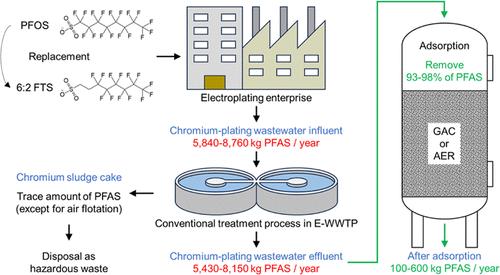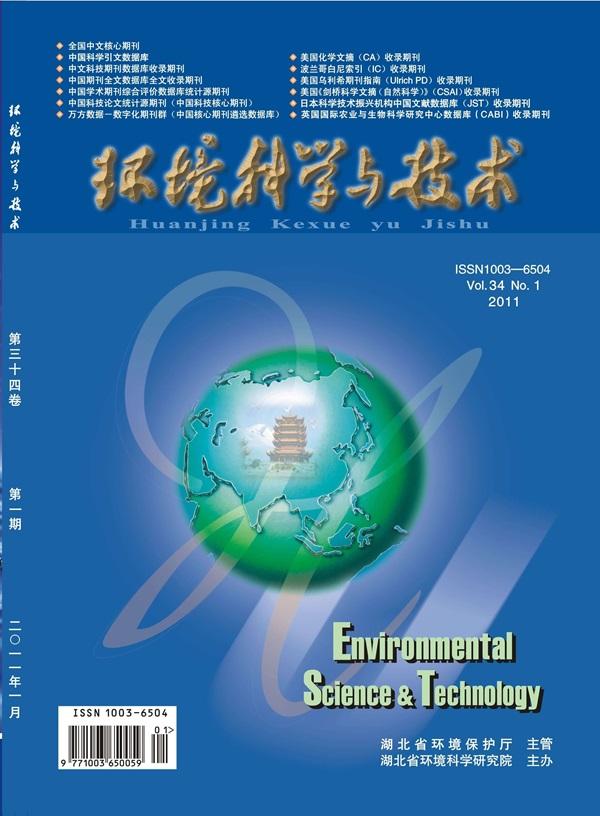Occurrence, Transport, and Full-Scale Adsorptive Removal of PFAS in Electroplating Parks in China
IF 11.3
1区 环境科学与生态学
Q1 ENGINEERING, ENVIRONMENTAL
引用次数: 0
Abstract
The electroplating industry is an important source of per- and polyfluoroalkyl substances (PFAS) contamination, but there is a lack of comprehensive studies on the occurrence, transport, and removal of PFAS in electroplating parks. In this study, we investigated typical electroplating parks in China and conducted the first full-scale removal of PFAS from chromium-plating wastewater using pore-enlarged granular activated carbon (GAC) and hydrophobic anion exchange resin (AER). The results showed that 6:2 fluorotelomer sulfonate (6:2 FTS) gradually replaced perfluorooctanesulfonate (PFOS) in China’s electroplating industry. The conventional reduction-sedimentation process hardly removed 6:2 FTS from chromium-plating wastewater, while the special air flotation process resulted in over 60% of PFOS entering the chromium sludge cake. Based on the full-scale evaluation, GAC and AER adsorption were feasible technologies for removing PFAS from chromium-plating wastewater, among which AER had higher adsorption capacity and removal efficiency for PFAS but poorer selectivity for 6:2 FTS than for PFOS. It is estimated that GAC and AER adsorption have the potential to reduce the discharge of PFAS by 5030–8000 kg/year in China. This study reveals the current status of PFAS contamination in China’s electroplating industry and provides feasible technologies for PFAS control.

中国电镀园区PFAS的发生、迁移和全面吸附去除
电镀工业是全氟烷基和多氟烷基物质(PFAS)污染的重要来源,但目前对电镀园区PFAS的发生、运输和清除缺乏全面的研究。本研究以中国典型电镀园区为研究对象,首次采用增孔颗粒活性炭(GAC)和疏水阴离子交换树脂(AER)对镀铬废水中的PFAS进行了全面去除。结果表明,6:2氟端粒磺酸盐(6:2 FTS)在中国电镀行业逐渐取代全氟辛烷磺酸(PFOS)。传统的还原沉降工艺对镀铬废水的去除率仅为6:2,而特殊的气浮工艺导致PFOS进入铬污泥饼的比例超过60%。经全面评价,GAC和AER吸附是去除镀铬废水中PFAS的可行技术,其中AER对PFAS的吸附量和去除效率较高,但对6:2 FTS的选择性较差。据估计,GAC和AER吸附有可能使中国的PFAS排放量减少5030-8000 kg/年。本研究揭示了中国电镀工业中PFAS污染的现状,为PFAS的控制提供了可行的技术。
本文章由计算机程序翻译,如有差异,请以英文原文为准。
求助全文
约1分钟内获得全文
求助全文
来源期刊

环境科学与技术
环境科学-工程:环境
CiteScore
17.50
自引率
9.60%
发文量
12359
审稿时长
2.8 months
期刊介绍:
Environmental Science & Technology (ES&T) is a co-sponsored academic and technical magazine by the Hubei Provincial Environmental Protection Bureau and the Hubei Provincial Academy of Environmental Sciences.
Environmental Science & Technology (ES&T) holds the status of Chinese core journals, scientific papers source journals of China, Chinese Science Citation Database source journals, and Chinese Academic Journal Comprehensive Evaluation Database source journals. This publication focuses on the academic field of environmental protection, featuring articles related to environmental protection and technical advancements.
文献相关原料
公司名称
产品信息
百灵威
perfluorooctanoic acid (PFOA)
百灵威
PFOS
阿拉丁
ammonium acetate
阿拉丁
ammonium hydroxide
阿拉丁
ammonium acetate
阿拉丁
ammonium hydroxide
 求助内容:
求助内容: 应助结果提醒方式:
应助结果提醒方式:


